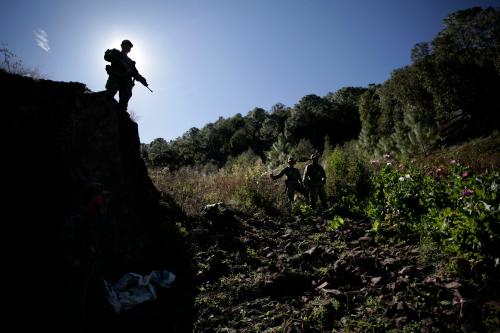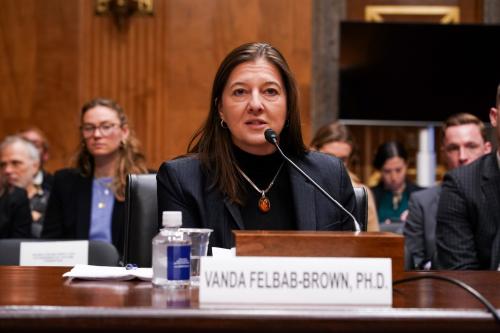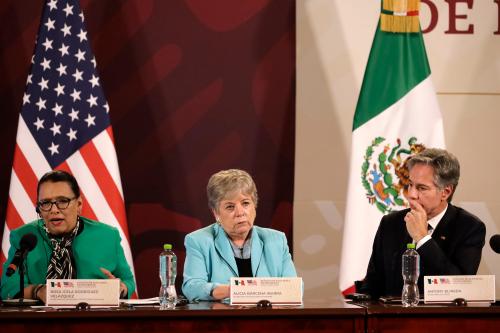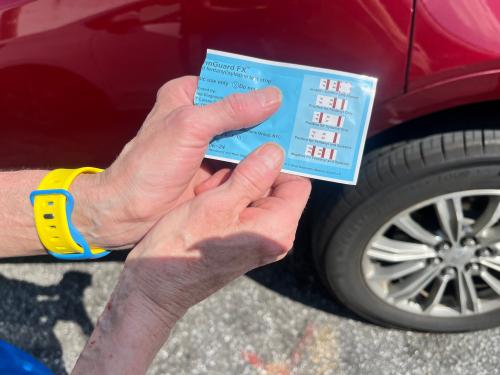Vanda Felbab-Brown explores the changing presence and increasing drug-product diversification of the Sinaloa Cartel and Cartel Jalisco Nueva Generación in Europe. This piece was originally published by Mexico Today.
The bipolar competition between the two largest Mexican cartels — the Sinaloa Cartel and Cartel Jalisco Nueva Generación (CJNG) — has spread around the globe. In Latin America, as I have written in this series, the competition has pushed up violence – dramatically amplifying conflict and homicide rates from Colombia to Ecuador and Chile. In the Asia-Pacific region, the foreign policies of the Sinaloa Cartel and CJNG have in recent years also become more provocative, as I detailed in my second column in this series. In Africa, the presence of the two cartels has been often behind-the-scenes and through proxies, but it is far greater than many imagine, as I showed in the third column. In today’s column and the next one, I explore the changing presence and increasing drug-product diversification of the Mexican cartels in Europe.
Starting in the late 1990s/early 2000s, the first phase of the Mexican cartels’ European presence centered on the supply of the cocaine to Europe and in the second, from 2015 onward, on the production of methamphetamine for export to the Asia-Pacific region. The third phase entails the production in Europe of highly potent cocaine, which I will discuss, along with key on-the-horizon questions and issues and the Middle East, in the subsequent and concluding column in this series.
Not surprisingly, the first entry point of the Mexican cartels into European crime markets was through cocaine. After a 15-year lag behind North America, cocaine consumption finally took off in Western Europe in the second half of the 1990s, and drug traffickers rushed to supply the new market. Colombian drug trafficking organizations (DTOs) and eventually the Mexican ones rapidly developed wholesale supply relationships with Italian mafia groups, especially the Calabria-originating Ndrangheta whose workforce is believed to have some 30,000 and whose budget is estimated in the tens of billions annually. As the fortunes of the Colombian cartels waned and the Mexican ones rose to the top echelons of the global drug trafficking pecking order, they also came to dominate the European cocaine supply just when cocaine consumption eclipsed heroin in Europe.
With an estimated minimum retail value of US $11.5 billion in 2020, cocaine is the second most commonly consumed illicit drug in Europe, after cannabis, and the Sinaloa Cartel is likely the premier wholesale supplier of cocaine for Europe. But it does not have anywhere near a monopoly on cocaine supply to the old continent. Cartel Jalisco Nueva Generación (CJNG) has followed it to Europe, like it did to the Asia-Pacific and Africa. Other wholesale, distribution, and retail criminal groups operate in Europe, such as Colombian, Albanian-speaking, British, Dutch, French, Irish, Serbian, Spanish, Turkish, and Moroccan criminal groups as well as outlaw motorcycle gangs.
Indeed, consistent with the Mexican cartels’ behavior and foreign policies in Africa and for a long time also in Asia, the cocaine business partnerships have entailed a quiet and relatively limited presence of Mexican criminal operatives in Europe and up to now no significant presence in European retail markets.
As Elisa Norio notes in her innovative article “Why are tourist resorts attractive for transnational crime?,” tourist hubs in Italy, Spain, such as Marbella, and the Mayan Riviera in Mexico provided crucial and convenient meetings hubs for the emissaries of the Mexican cartels and Italian mafia groups to liaise.
Beyond making it easier for the DTOs to hide from law enforcement, there were other reasons why tourist resorts and important transportation ports and hubs in Italy and Spain as well as in Belgium and the Netherlands developed into some of the key bases of operations for the Mexican cartels’ cocaine trafficking to Europe. Italy and Spain are conveniently geographically connected to what emerged as key drug shipment routes from Latin America through the Caribbean and West and North Africa, such as Morocco. And the Low Countries operate some of the largest ports in Europe and have their historic connections to the Caribbean. The transportation hubs of Antwerp in Belgium, Amsterdam and Rotterdam in the Netherlands, and Algeciras in Spain have become some of the largest cocaine valves into Europe.
Consistent with its modus operandi in North America, the Sinaloa Cartel has attempted to diversify not only the cocaine supply routes to Europe, but also the means of supply. For example, a 2019 Italian law enforcement investigation — Operation HALCON — uncovered efforts by the Sinaloa Cartel to set up operations in the Sicilian city of Catania, seemingly an off-the-radar backwater, but a rapidly emerging tourist destination with a small international airport for landing small planes carrying cocaine from Latin America across the Atlantic. Catania was chosen as a test run for other potential coke flights from Latin America, which would refuel in West Africa, such as in Capo Verde. Two Sinaloa operatives were dispatched to Italy to liaise with local Ndrangheta contacts and supervise local arrangements for weeks in advance. The Sinaloa boss, José Angel “El Flaco” Rivera Zazueta, a top lieutenant of Ismael “El Mayo” Zambada, would come to Italy only for the final stages. Based in Asia and living in places such as Taiwan, “El Flaco” had principally focused on managing the Sinaloa Cartel’s synthetic drug trafficking in Asia.
The ingenious and daring law enforcement operation — involving Italian law enforcement officers bugging meeting places and setting up false roadblocks, multiple sting operations in Colombia with planted informers and operators and gutsy Colombian counternarcotics agents going undercover into Cauca to meet up with FARC dissident leaders churning out cocaine — produced a treasure trove of information about drug operations beyond Europe. Among them (and boasted about by Zazueta) was the Venezuelan military’s assistance in dispatching of scores of small planes loaded with cocaine weekly from Venezuela to Chetumal, a Mexican resort town near Belize.
Equally fascinating were the intended recipients of the Sinaloa Cartel’s cocaine run through Catania: yes, the ‘Ndrangheta for its distribution in Western Europe, but also a Chinese criminal group. As I explored in the second column in this series, the Sinaloa Cartel had long cooperated with the triads in trying to build up a growing Chinese and Asian cocaine market.
In about 2015, the Sinaloa Cartel made a radical change in its Asia-Pacific foreign policy. For the set of reasons I had previously detailed, it decided not just to use the Asia-Pacific area for procuring meth and synthetic opioid precursors and developing cocaine markets, but also to begin supplying meth to the Asia-Pacific region, thus threatening the triads’ crystal meth empire there.
Some of the meth for the Asia-Pacific supplied by the Sinaloa Cartel and CJNG came from Mexico where Mexican cooks had developed high-potency meth solely from legal dual-use precursors.
But with its entrepreneurial drive, the Sinaloa Cartel looked to diversify sources of production, and settled on the Netherlands in 2015, setting off Phase II of the Mexican cartels’ presence in European drug markets. Until the arrival of the Mexicans, the large illegal drug industry in the Netherlands avoided making methamphetamine, a drug with terrible substance use disorder effects including devastating morbidity and low recovery rates. Instead, it was satisfied cooking less harmful drugs, such amphetamine (Speed) and Ecstasy (MDMA) as well as LSD. Meth production and consumption in Europe were essentially limited to Czechia where in addition to Czech groups, Vietnamese criminal groups have also been involved in meth production and trafficking, like they have been in wildlife trafficking.
But with the presence of the Mexicans, the first meth lab was discovered in the Netherlands in 2015. In 2020, 32 meth labs were supposedly discovered in the country.
Importantly, during one meth lab bust in May 2019, three Mexican drug cooks were captured. Cumulatively, between 2019 and 2020 alone, some 20 Mexican meth cooks were arrested in Europe.
The Mexican cooks brought to the Netherlands a technique of producing very potent meth from the abundant precursor BMK without having extensive waste by converting the waste also into a more potent, addictive, crystal meth known as d-meth. D-meth would also produce very large crystals, some as large as a human arm, which became the rage among drug users in Asia and the Pacific. A kilogram of meth would sell in the Netherlands for some USD 17,000, USD 35,000 -78,000 in Japan, and USD 60,000-206,000 in Australia.
Significantly, some MDMA labs appeared to be switching to the production of meth.
Technically, the switch was easy: a lab producing amphetamine or MDMA would already have the knowhow, equipment, and established precursor supply networks across Europe and into China. The far more complicated decision in switching to meth involved judgements about the reaction of the Dutch law enforcement authorities.
The Dutch MDMA operations long enjoyed a lesser-intensity of enforcement from Dutch authorities because they stuck to less dangerous illicit drugs, such as MDMA, and thus the illegal drug operations in the Netherlands would face less intense criminal prosecution. But the expansion of the Mexican cartels appears to have changed the risk-profit calculation. Perhaps they calculated that as long as the meth was exported to the Asia-Pacific region and did not head to Dutch and European users, they would not incur substantially greater wrath from law enforcement and more intense criminal prosecution. But would consumption stay limited to just customers far away from production?
Just as in the Asia-Pacific region and Africa, the CJNG has followed Sinaloa into Europe. Its operatives, such as Carlos Rubén Ramírez Monroy, who had since been arrested in Romania and extradited to the United States, have been setting up meth production and smuggling operations in Europe as well as developing new cocaine trafficking networks to compete with the Sinaloa Cartel. In an uncanny parallel with Sinaloa’s “El Flaco”, Ramírez Monroy himself was also involved in CJNG’s drug trafficking in the Asia-Pacific.
Indeed, the decision of the Mexican Cartels to start supplying the Asia-Pacific meth markets turned out to be a key factor altering their presence and operations in Europe.
But what the Mexicans learned during their operations in the Asia-Pacific — namely, the advantages of a superior highly potent product – they also incorporated back into their European operations, namely — cooking a very potent cocaine in Europe itself (the subject, along with the key questions and issues on the horizon, of the next, concluding column in this series).







Commentary
Op-edThe foreign policies of the Sinaloa Cartel and CJNG — Part IV: Europe’s cocaine and meth markets
September 2, 2022